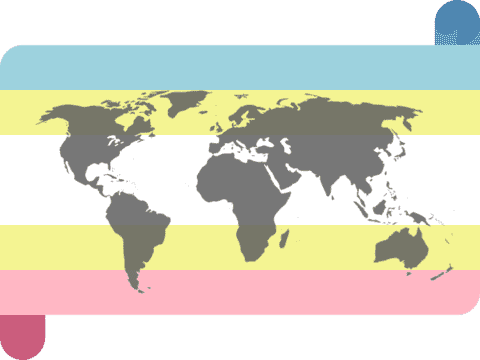
By now, you've probably heard about minor-attracted people (MAPs). Depending on who you talk to, you may have been told that the term is an attempt to rebrand or "normalize" pedophiles, that MAPs are trying to make child sexual abuse legal and socially acceptable, or that they want to infiltrate the LGBTQ community. However, these claims are misleading and reflect a coordinated effort to spread misinformation and encourage bigotry.
What is a MAP?
As the name suggests, a minor-attracted person is somebody who experiences attractions to minors. These attractions are usually sexual, however, some MAPs experience romantic, aesthetic, or some combination of attractions to minors. The term was popularized by mental health experts as an umbrella term for the four minor attractions: nepiophilia (attraction to infants and toddlers), pedophilia (attraction to prepubescent children), hebephilia (attraction to pubescent teens), and ephebophilia (attraction to post-pubescent minors). "MAP" is now widely used in research and considered established terminology by researchers and other experts in various fields.
"MAP" only describes attractions (which are unchosen) and does not indicate whether or not someone has committed a sexual offense, despite widespread misconceptions to the contrary. It is also not an attempt to "rebrand" pedophiles, which are simply a category of MAPs. Both experts and MAPs continue to use the term pedophile to describe people who are attracted to prepubescent children. Some people prefer to use the term MAP when discussing pedophiles because they believe "MAP" carries less stigma and is therefore easier for the average person to understand, but this is a matter of personal preference and does not make abuse more acceptable.
The minor-attracted person movement
Some MAPs and individuals who support them speak out against the stigma that allows misinformation about MAPs to gain traction and makes it difficult for MAPs to seek support. This advocacy can take a variety of forms, such as correcting false claims and sharing resources with MAPs in need of support. Despite pushback from critics, child protection and sexual violence prevention experts have pointed out that MAP activism can reduce the risk of a MAP committing a sexual offense.
Mischaracterizations
Unfortunately, due to widespread fearmongering about MAPs (often perpetuated by groups that stand to benefit financially or socially from the resulting hysteria), many people have been given misleading information about the objectives of the MAP movement. Among these is the idea that MAPs and their supporters have the end goal of making child sexual abuse legal and socially acceptable. While there was a time when groups like NAMBLA (which opposed age-of-consent laws) were the leading force in MAP-related advocacy, this is no longer the case. Today, the most mainstream voices in MAP activism are supported by child protection experts and work to help MAPs who are at risk of offending find support.
It is common for critics of MAP advocacy to accuse MAPs and their supporters of trying to "normalize pedophilia." This manipulative claim takes advantage of the common misconception that pedophilia is a synonym for child sexual abuse. Even when people are aware of the correct definition of pedophilia as nothing more than a pattern of attractions, this claim still plays on the widespread belief that reducing the stigma surrounding pedophilia and other minor attractions would increase the likelihood of MAPs offending. In reality, decreasing stigma would likely prevent abuse.
MAPs and LGBTQ
In 2016, a group of 4chan users launched a disinformation campaign aimed at convincing the public that pedophiles were becoming part of the modern LGBTQ community. Known as HeartProgress, the campaign aimed to tarnish the LGBTQ community's image and undermine the rights they had spent decades fighting to obtain.
Although HeartProgress failed to directly impede the LGBTQ movement, it did convince countless people that pedophiles were seeking inclusion. To this day, even members of the LGBTQ community, continue to incorrectly claim that MAPs are pushing to have their attractions considered LGBTQ identities. This, combined with the widespread misconceptions about MAPs discussed earlier, fuels the modern far-right conspiracy theories that the LGBTQ community is full of groomers and predators.
Despite the lack of any significant connection between MAP activism and the present-day LGBTQ community, critics often point to the movements' similarities as evidence that MAPs want to be considered LGBT. These include the fact that both communities have a concept of pride, represent themselves using flags, and describe themselves as queer.
Of course, it is absurd to claim that the LGBTQ community has a monopoly on the concept of pride, the use of flags, or the word queer. Most of these similarities can be attributed to the fact that the two movements have similar objectives: fighting the stigma and discrimination they experience due to non-normative attractions. Furthermore, after consulting sources affiliated with each group, fact-checkers determined that the existence of a MAP pride flag did not indicate a push for minor-attracted people to be included in the LGBTQ community.
That being said, some MAPs have LGBTQ identities in addition to their attractions to minors and can therefore be considered LGBTQ. Additionally, sexuality experts consider minor attractions to be sexual orientations and queer identities, albeit separate from the LGBTQ community. As a result, some have called for a united "queer community," which would include the LGBTQ community, MAPs and other paraphiles, kinksters, and anyone else with stigmatized identities. However, there have been no major efforts to create such a community, and doing so does not seem to be a primary goal for MAP activists.
Goals of MAP activism
- The right to good-faith assumptions, privacy, and safety
- The right to free and universally-accessible information on MAP-related topics
- The right to gather and support each other without interruption
- The right to be included and prioritized in discussions on minor attractions
In creating our own summary of MAP rights, we identified two major categories:
MAPs face numerous sources of distress due to the stigma surrounding their attractions. This can lead to a variety of mental health issues, some of which are risk factors for offending. Unfortunately, this same stigma enables abuse and prevents MAPs from seeking support when they need it. Stigmatizing views held by mental health professionals can put MAPs at risk of being reported under mandatory reporting laws if they disclose their attractions to a therapist, even if they have never committed any crime. A reduction in stigma would make it easier for MAPs to seek support, improving wellbeing and ensuring MAPs who are at risk of offending are able to get the help they need. Contrary to popular belief, the MAP movement has played a major role in making this support more widely available.
MAPs are often excluded from legal protections for marginalized groups. As a result, MAPs who are outed may be deprived of housing, jobs, and equal treatment on the basis of their attractions, even in regions with strong anti-discrimination laws. This exception is based on the false premise that MAPs are likely or guaranteed to abuse a child, and therefore must be mistreated in order to prevent them from offending. This increases the risk MAPs face when disclosing their attractions to friends and family members, adding feelings of isolation to the numerous challenges they already encounter. Supporting, rather than mistreating, MAPs who come out or are outed would make it safer for MAPs to ask for help when they need it and reduce the prevalence of mental health issues among the minor-attracted population.
Want to help MAPs in their fight for support and acceptance? Learn how
Are you a MAP in need of support? View resources





Subscribe